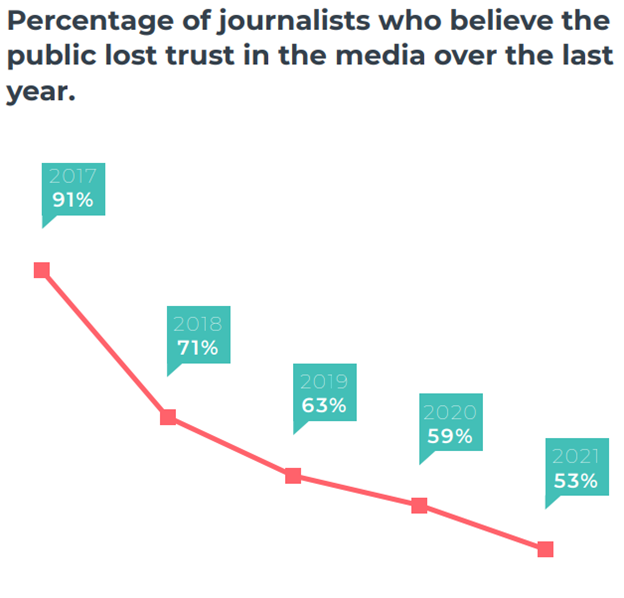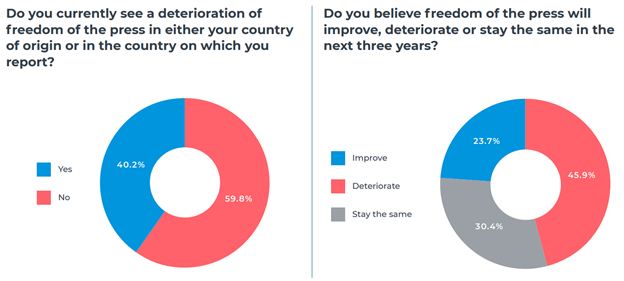In its 2021 Global State of the Media Report, the solution for the Cision press relations paints a picture of the current media landscape and reveals how PR professionals can improve their collaboration with journalists. Here are the highlights.
With its relentless succession of crises, 2020 has marked newsrooms around the world forever. Today, the media still face a range of challenges that influence various facets of their profession, such as their editorial strategies, their way of working and their expectations of public relations (PR) professionals.
In this 12th annual Cision survey, more than 2,700 journalists from 15 countries were surveyed between February 1st and March 1st, 2021. The objective: to understand the main challenges facing the media, the best and worst days and times to propose a collaboration and perform a follow-up or the missteps to avoid landing on the blacklist or be blocked by journalists.
What are the challenges facing the media today?
- Public trust
According to journalists, the public’s trust in the media has steadily improved over the past five years… But there is still a long way to go!
More than half of the journalists surveyed in the Cision survey (53%) believe that public trust in the media has deteriorated over the past year, compared to 59% the year before.

In the United States where the heated relationship between the White House and some of the media has been aired publicly over the last four years, 36% of journalists surveyed believe the new US Presidential administration will help the media regain public trust.
- Censorship also remains a major concern
Nearly half of the world’s journalists (46%) predict that freedom of press will continue to deteriorate over the next three years.

- Journalists are really busy
In newsrooms with fewer and fewer staff, journalists must juggle multiple specialty areas, a large workload, and tight deadlines.
Almost half of journalists (47%) cover at least 5 areas and write at least 7 articles per week, or at least 10 in the case of 33% of respondents.
A lesson for relationists: journalists do not have time to chase down stories! By giving them all the information, they need up front (insightful data, relevant quotes and accompanying images), press relations professionals can make the job of journalists easier.

Tips to be relevant
Already, PR professionals need to create more targeted media contact lists. Each week, 53% of journalists receive more than 50 pitches and 28% receive more than 100 per week.
Despite the abundance of stories, 69% of journalists say only a quarter (or less) are relevant to their audiences. What should be retained? Relevance is crucial.

According to 61% of journalists, one of the steps PR professionals can take is to become familiar with their target audience and topics of interest. One of the respondents stated:
“99% of those emailing me have never even read a story I wrote. I don’t expect every single pitch to be 100% relevant, but if you have no idea of my beat, you’re just spamming me.”
Before reaching out to journalist, relationists must therefore do the necessary research to ensure that the story proposed will be of interest to the journalist’s audience. Otherwise, the pitch is likely to end up in the trash, and everyone’s time and energy will have been invested in vain!
Also, journalists seem to love Mondays … at least when it comes tot getting pitched! Most journalists surveyed (60%) prefer to receive pitches on this day, while Tuesdays are also suitable for 43% of respondents.
However, many (28%) prefer pitches on Friday or over the weekend, likely because it gives them content to post over the weekend or prepare for the following week.

Respondents also indicated that they would like to receive press releases (78%), content supported by original research reports (68%) and multimedia elements (photos, videos, etc.) as well as be invited to expert interviews or events.
According to a journalist interviewed:
It is unthinkable for a PR professional or a PR agency to send a news release without images or logo. I am not aware of any websites or publication sources that publish articles without images and have time to search for visuals or logos.”

PR professionals must take the lead, monitor current issues and react quickly. Due to increased competition for audiences, journalists carefully assess the relevance of topics, which contributes to web traffic and social media sharing (and ultimately advertising revenues).

Many journalists need two to three days (or more) to review a PR professional’s pitch.
In fact, almost three out of ten journalists say they never want a follow up. The worst times to follow up with them are the start and end of the workday (before 8:00 am and after 4:00 pm), while the best times are usually between 8:00 am and noon.

Missteps to avoid with journalists
Emails with irrelevant content, as we have seen, proposals to collaborate like marketing brochures, lack of transparency and excessive follow-up are among the journalists’ main pet peeves.

However, journalists recognize the added value of relationists and agree to be helped… Provided it meets their needs.

A word to the wise!
The survey methodology
The surveys were emailed to Cision Media Database members, as media professionals, influencers and bloggers, from February 1st to March 1st, 2021. This year’s survey included 2,746 respondents from 15 countries: United States, Canada, United Kingdom, France, Germany, Finland, Sweden, Italy, Spain, Portugal, Brazil, Mexico, Korea, Vietnam and Malaysia.




